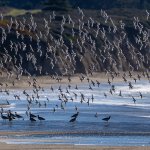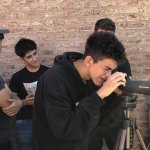From Canada to Argentina, Western Hemisphere Shorebird Reserve Network partners explain the value of WHSRN and the benefits of WHSRN designation.
By: James Lowen
Leia esta história em português aqui.
When booking accommodation, we are unlikely to take a hotel’s ‘pitch’ at face value. Instead, we seek objective corroboration by reading guest reviews – the good, the bad and the below average. Similarly, to understand the true value of a wide-ranging conservation initiative such as the Western Hemisphere Shorebird Reserve Network (WHSRN), we need perspectives from those who have chosen to be members. Over 430 partners have taken the initiative to nominate their important shorebird site to WHSRN, but why?
Encompassing 15.7 million hectares of shorebird habitat across 19 countries, 115 sites or landscapes have criteria established by the WHSRN Hemispheric Council (an Americas-wide assemblage of shorebird experts) for regional, international or hemispheric importance. But does this badge of approval justify the effort of a potentially daunting nomination process?
The answer from partners — a resounding, yes, a designation has great value at the site. Put simply, designation vouches for a place’s importance for shorebirds. Organizations can use this to secure formal government protection, engage communities with conservation or persuade landowners to integrate shorebirds in planning. At Canada’s Fraser River Estuary, James Casey (Birds Canada) explains, “WHSRN designation provided local champions with an internationally recognized standard highlighting the estuary’s importance for shorebirds to engage decision-makers,” he adds. “It legitimizes claims that the Fraser Estuary is an international – and therefore national – conservation priority.”
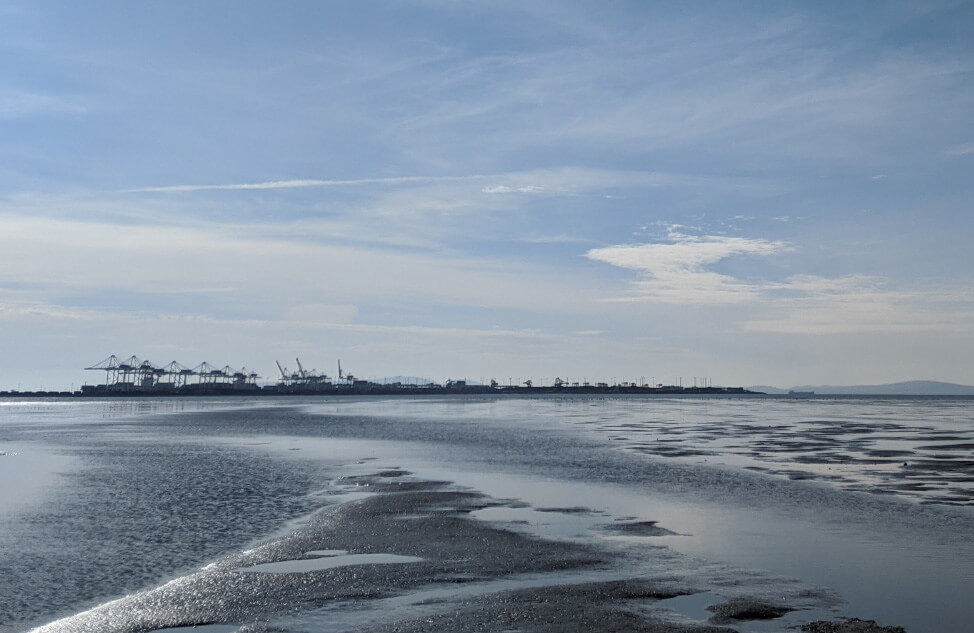
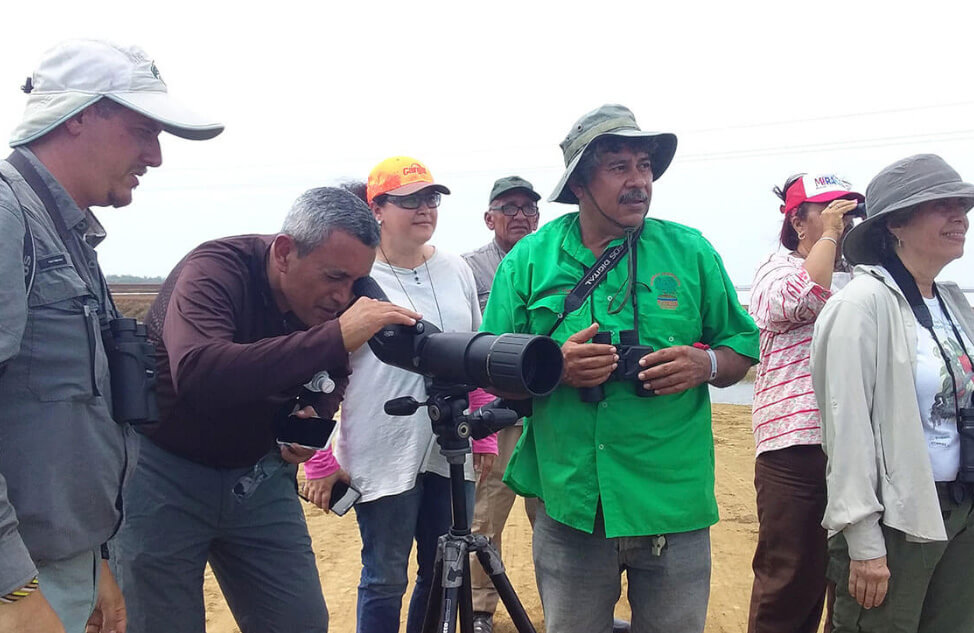
Left: The current container terminal at Robert’s Bank can be seen across the mudflats of the Fraser River Estuary WHSRN Site. Photo: Laura Chamberlin. Right: Team from MANGLE, PRODUSAL, and Audubon Society of Venezuela counting shorebirds at the Salina Solar Los Olivitos WHSRN Site. Photo: L. Torres.
Alice Keyes, Vice President of Coastal Conservation for One Hundred Miles identifies multiple benefits in WHSRN designation for the Georgia Barrier Islands (USA). “It helped us raise awareness about the importance of protecting wild habitats, educate residents and visitors about the international role our coast plays for migratory shorebirds, and advocate for stronger state laws.” Sandra Giner (Universidad Central de Venezuela) also highlights management opportunities: “The primary benefit of WHSRN nomination for Venezuela’s Salina Solar Los Olivitos lies in encouraging the landowner, PRODUSAL, to develop a management plan that incorporates shorebird conservation.”
Designation also opens doors to funding for shorebird conservation. “Having our Barba Azul Nature Reserve declared a WHSRN Site for its passage Buff-breasted Sandpipers (Calidris subruficollis) – and thus a priority site for conservation, internationally speaking – helped us receive funding,” Tjalle Boorsma (Armonía) enthuses. “We have received multiple years of support from the Neotropic Migratory Bird Conservation Act program plus funds specifically to help the species.”
Thanks to WHSRN, donors nor decision-makers need rely solely on an applicant’s word about a location’s importance for shorebirds. No location becomes a WHSRN Site without robust, impartial evidence of its significance. This also helps, James explains, when “science underpinning an assessment of the impacts of a proposed development is hotly contested,” as in the proposed expansion of a container terminal at Robert’s Bank (a vital stretch of Fraser Estuary).
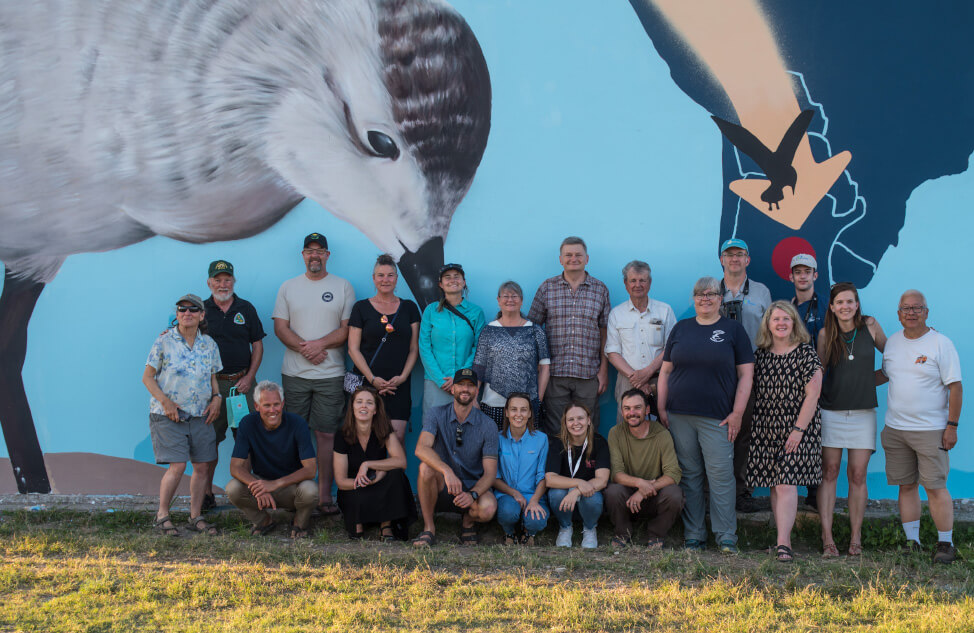
International delegation and local organizers in front of mural celebrating the sisterhood between the three salt lakes – Laguna Mar Chiquita in Argentina, Mono Lake and Great Salt Lake in the United States. Photo: Fundación Líderes de Ansenuza.
Important though designation is, it is just one component of WHSRN’s value. Another is inherent in the final word of the name: Network. At a Western Hemisphere Shorebird Group meeting, attendees offered personal views on the most valuable part of being a WHSRN Site. A single thread ran through their answers: the Network’s people. – connections, collaboration, and coordination of people. Ryan Carle (Oikos Ecosystem Knowledge, USA) went further: “Without the Network, we would have been in isolation”, he said, “but the support, expertise and advice from WHSRN folks has been incredible for making things happen”.
Opportunities to learn from the wealth of experience among WHSRN’s partners can be informal (side conversation at an event) or structured (exchange programs). These work because WHSRN Sites often share values, goals, challenges and species – five shorebirds, including Whimbrel (Numenius phaeopus) and Snowy Plover, have triggered designations at ten or more sites. And these opportunities succeed because partners develop strong relationships that foster sharing, build capacity and inspire new activity.
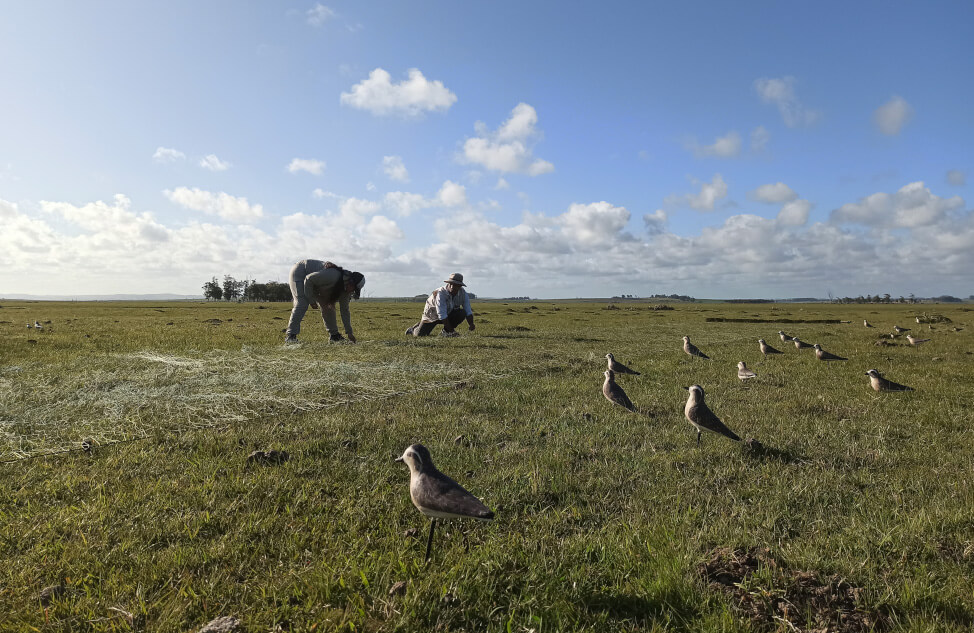
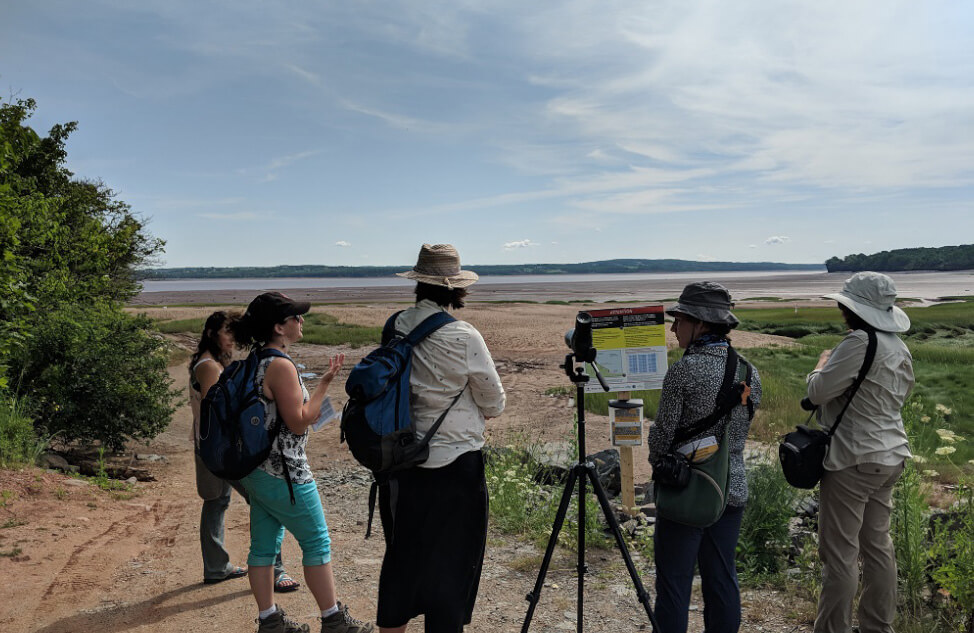
Left: Partners from the Barba Azul WHSRN Site visited the Laguna Rocha WHSRN Site to learn about setting a net for trapping shorebirds. Photo: Marcia Salvatierra. Right: Partners from Georgia Barrier Islands and Delaware Bay visit the Bay of Fundy, learning more about how Birds Canada is reducing disturbance of roosting shorebirds with their Space to Roost program. Photo: Laura Chamberlin.
Exchange programs in the Pacific and Atlantic flyways have informed, engaged and connected communities at key sites for Red Knot (C. canutus) and Semipalmated Sandpiper (C. pusilla). Bay of Fundy (Canada) partners learned from Delaware Bay (USA) how to improve the Dorchester Shorebird Festival, while those from Delaware Bay and the Georgia Barrier Islands (USA) journeyed north to understand experiences of communicating with recreational users of shorebird habitats. “To prevent people disturbing shorebirds,” Alice Keyes says, “we looked to other WHSRN Sites for examples of educational programs that inform people of the impacts of beachgoers and dogs”.
Partners from Willapa Bay and Grays Harbor Estuary (USA), and Bahía de Todos Santos (Mexico), travelled to Alaska’s Copper River Delta (USA) to learn best practice on developing sustainable bird-based tourism opportunities. This helped Vanessa Loverti (US Fish and Wildlife Service) and colleagues “implement our own bird festival, Wings over Willapa, and make it a successful, educational experience”. Grays Harbor and Willapa Bay then hosted Alaskan and Mexican partners, building capacity in participative shorebird research. “Without WHSRN and the lasting partnerships opened up by the exchanges, none of this would have occurred,” Vanessa says. “We are all learning from one another, sharing our successes and failures.”
“Without WHSRN and the lasting partnerships opened up by the exchanges, none of this would have occurred. We are all learning from one another, sharing our successes and failures,” shared Vanessa Loverti.
WHSRN’s partner base harbors some of the world’s finest shorebird biologists. Access to cutting-edge science on shorebird population trends, migration routes, and conservation are key benefits of being part of the Network. Within WHSRN experience is freely shared. Take Buff-breasted Sandpiper, for example. “Studies of the species’ ecological needs from WHSRN sites and researchers,” Tjalle explains, are helping Armonía manage its Barba Azul reserve. “Being part of WHSRN gives you direct contact with key shorebird experts and makes communication easy. Learning that using livestock to keep grass short or burning small areas of tall grass has helped me better understand strategies to create optimum stopover habitat.” In Venezuela, Sandra explains that conservationists are similarly applying experience gained from Asociación Calidris to help Buff-breasted Sandpipers in the Llanos. It all adds up.
Partners also emphasize the importance of WHSRN’s beating heart – its Executive Office. The WHSRN Executive Office, housed within Manomet, Inc, provides administrative, technical, and outreach services. This can include engaging decision-makers, leveraging funding, convening stakeholders, and building capacity.
Every WHSRN partner has access to site support from this bureau of shorebird expertise. Since 2017, 650 people have benefited from 37 trainings, webinars, and workshops, covering topics as diverse as improving governance, strengthening monitoring, assessing ecosystem services and engaging communities. At Bahía Blanca in Argentina, Pablo Petracci (Universidad Nacional del Sur) lauds WHSRN’s contribution to good governance, “bringing the port management authority to the management table”. This resulted in “decisions about dredging and intervention being made jointly, where possible”. Sandra praises WHSRN monitoring and governance workshops, which “had positive impacts and strengthened community engagement – both locally and nationally”. Increased monitoring capacity has elicited “valuable information about poorly known species” in Venezuela, “demonstrating the coast’s importance for migratory shorebirds” and informing the prospective nomination of three candidate WHSRN Sites.
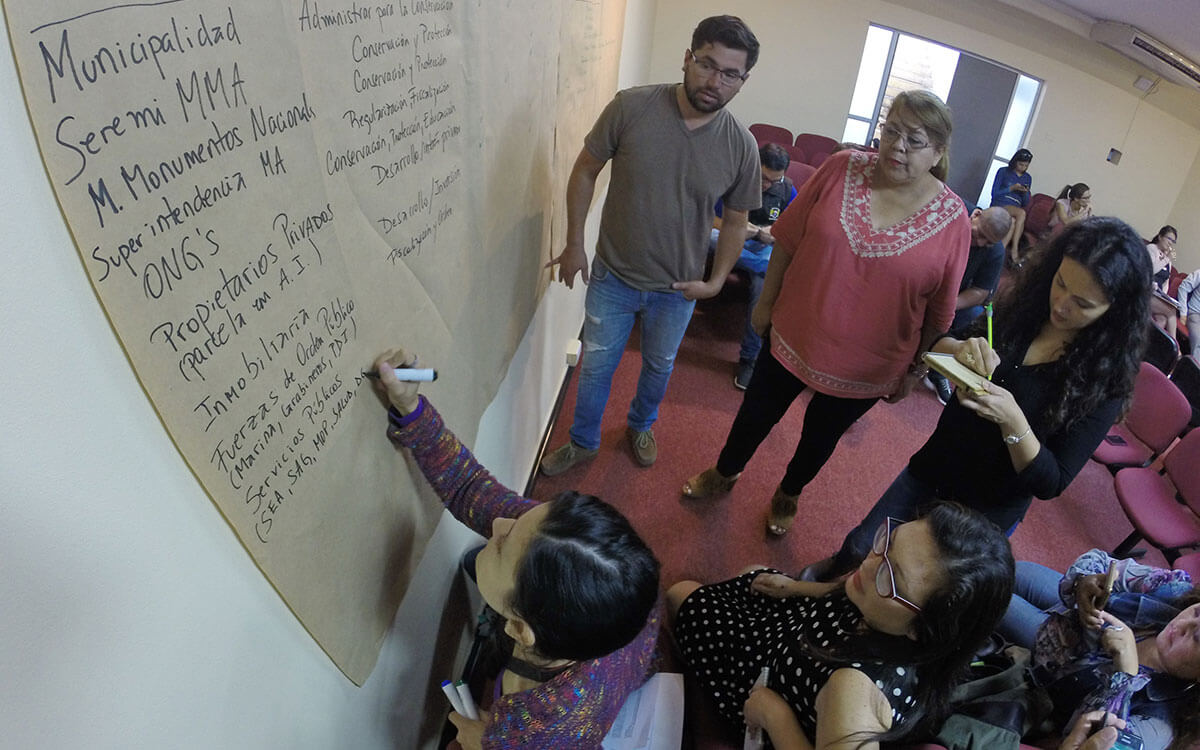
Group discussions and collaborative exercises were a key part of the workshop about the conservation and management of the Humedal del Río Lluta WHSRSN Site. Photo: Diego Luna Quevedo.
Yes, a WHSRN designation strengthens the case for diligent management, formal protection, and increased funding bids. Important though these benefits are, what comes across most stridently from those involved in conserving migratory shorebirds is that WHSRN is so much more than a label. Its Network is all about partners, and its partners are all about people. And those people are all conservation champions, lining flyways through the Americas, to help shorebirds along their ever-perilous journeys – but also to support one another.
Cover Photo: Flags from countries with WHSRN sites at the dedication of the 100th WHSRN site, Georgia Barrier Islands. Photo: Laura Chamberlin.





